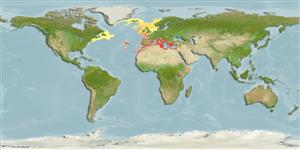Common names from other countries
Environment: milieu / climate zone / depth range / distribution range
Écologie
Pélagique; profondeur 0 - 1022 m (Ref. 122930), usually 100 - 300 m (Ref. 8). Subtropical; 60°N - 27°N, 19°W - 36°E
Distribution
Pays | Zones FAO | Écosystèmes | Occurrences | Introductions
Eastern Atlantic and the Mediterranean: from Scotland and Norway, south to Canary Islands and east to Turkey, eastern Mediterranean.
Length at first maturity / Taille / Poids / Âge
Maturity: Lm ?, range 1 - ? cm Max length : 2.2 cm CL mâle / non sexé; (Ref. 8)
Minimum depth from Ref. 8. Benthopelagic (Ref. 105772). Mesopelagic (Ref. 122930). Known from pelagic depths between 100 to 200 m (Ref. 92299). Abundant on the upper slope (Ref. 105772). Associated with the gorgonacean coral Isidella elongata (Ref. 122886). Found on seamounts (Ref. 122931). Carries out diel vertical migrations. Diet is based on pelagic crustaceans like euphausiids and calanoids, and bottom feeding has been reported to be minimal, as is the passive ingestion of forams. However, at night, large specimens feed near the bottom on suprabenthic gammarid amphipods. In general, predatory activity occurs higher in the water column at night (Ref. 105773).
Life cycle and mating behavior
Maturité | Reproduction | Frai | Œufs | Fécondité | Larves
Members of the order Decapoda are mostly gonochoric. Mating behavior: Precopulatory courtship ritual is common (through olfactory and tactile cues); usually indirect sperm transfer.
Williams, A.B., L.G. Abele, D.L. Felder, H.H. Hobbs Jr., R.B. Manning, P.A. McLaughlin and I. Pérez Farfante. 1988. (Ref. 2214)
Statut dans la liste rouge de l'IUCN (Ref. 130435)
statut CITES (Ref. 108899)
Not Evaluated
Not Evaluated
Utilisations par l'homme
Pêcheries: commercial
| FishSource |
Outils
Sources Internet
Estimates based on models
Preferred temperature
(Ref.
115969): 13.2 - 15.8, mean 14.3 (based on 141 cells).
Résilience
Haut, temps minimum de doublement de population inférieur à 15 mois (K=0.55-0.62).
Catégorie de prix
Unknown.
